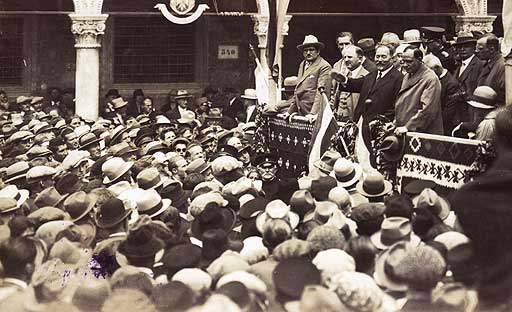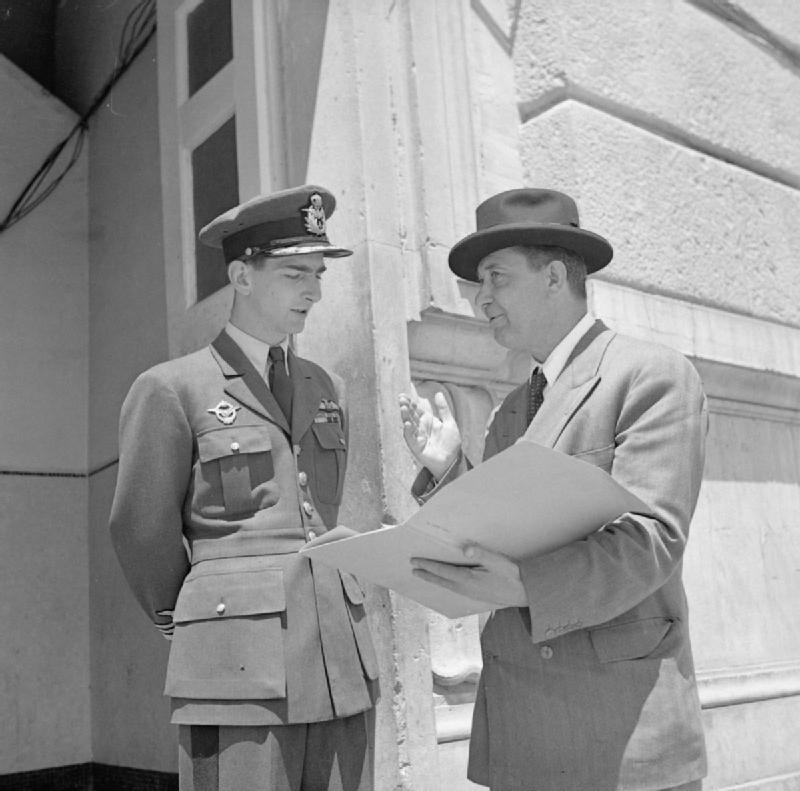|
1940 Croatian Local Elections
The 1940 Croatian local elections were held in 625 municipalities of the Banovina of Croatia on 19 May 1940, and in 33 municipalities on 26 May and 2 June. These were the first elections following the Cvetković–Maček Agreement and the establishment of the autonomous Croatian Banate within the Kingdom of Yugoslavia. The elections were not held in cities and some Adriatic counties bordering, or adjacent to, Italy. Only men older than 24 were allowed to vote. Voting was public and conducted by voice. The elections were a landslide victory for the Croatian Peasant Party (HSS) and the Independent Democratic Party (SDS), the ruling parties of the Banovina of Croatia, which together won a majority in 90% of municipalities. Serb independent lists, supported by organizations opposing the Cvetković–Maček Agreement, won around 5% of municipalities. The Yugoslav Radical Union (JRZ), the ruling party of the Kingdom of Yugoslavia, suffered a heavy defeat and lost control in 80% of its ... [...More Info...] [...Related Items...] OR: [Wikipedia] [Google] [Baidu] |
Croatian Peasant Party
The Croatian Peasant Party ( hr, Hrvatska seljačka stranka, HSS) is an agrarian political party in Croatia founded on 22 December 1904 by Antun and Stjepan Radić as Croatian Peoples' Peasant Party (HPSS). The Brothers Radić believed that the realization of Croatian statehood was possible within Austria-Hungary, but that it had to be reformed as a Monarchy divided into three equal parts – Austria, Hungary, Croatia. After the creation of Kingdom of Yugoslavia in 1918, Party requested for the Croatian part of the Kingdom to be based on self-determination. This brought them great public support which culminated in 1920 parliamentary election when HPSS won all 58 seats assigned to Croatia. In 1920, disgruntled with a bad position of Croats in the Kingdom, the party changed its name into Croatian Republican Peasant Party (HRSS) and started advocating secession from the Kingdom and the establishment of ''"peaceful peasant Republic of Croatia"''. On 1923 and 1925 election, HRS ... [...More Info...] [...Related Items...] OR: [Wikipedia] [Google] [Baidu] |
Littoral Banovina
The Littoral Banovina or Littoral Banate ( hr, Primorska banovina; sr, Приморска бановина, italics=no / ''Primorska banovina''), was a province ( banovina) of the Kingdom of Yugoslavia between 1929 and 1939. This province consisted of much of the Croatian region of Dalmatia and parts of present-day Bosnia and Herzegovina and was named for its coastal (maritime) location. The capital city of the Littoral Banovina was Split. Borders According to the 1931 Constitution of the Kingdom of Yugoslavia, :''The Littoral Banovina is bounded on the north by the southern boundaries already drawn of the Sava and Vrbas Banovinas as far as the intersection of the limits of the three districts of Jajce, Bugojno, and Travnik (Rakovce, hill 1217). From this point the boundary of the Banovina follows the eastern border of the district of Bugojno, then the northern boundary of the district of Konjic, to continue along the eastern boundary of the districts of Konjic and Mostar up to ... [...More Info...] [...Related Items...] OR: [Wikipedia] [Google] [Baidu] |
Lepoglava Prison
Lepoglava is a town in Varaždin County, northern Croatia, located southwest of Varaždin, west of Ivanec, and northeast of Krapina. Demographics A total of 8,283 residents in the municipality (2011 census) live in the following settlements: * Bednjica, population 209 * Crkovec, population 188 * Donja Višnjica, population 542 * Gornja Višnjica, population 271 * Jazbina Višnjička, population 25 * Kamenica, population 141 * Kamenički Vrhovec, population 205 * Kameničko Podgorje, population 322 * Lepoglava, population 4,174 * Muričevec, population 195 * Očura, population 188 * Viletinec, population 173 * Vulišinec, population 237 * Zalužje, population 162 * Zlogonje, population 412 * Žarovnica, population 839 History Lepoglava is probably best known for hosting the main Croatian prison, the Lepoglava prison. In 1854, a monastery of the Pauline Fathers was transformed by the authorities into a prison. In the twentieth century, the prison was used to intern ... [...More Info...] [...Related Items...] OR: [Wikipedia] [Google] [Baidu] |
RNK Split
Radnički nogometni klub Split, commonly known as RNK Split, is a Croatian football club based in the city of Split. History The club had a strong fanbase in the Split's shipyard. The club was founded on 16 April 1912 as Anarch, but has had several names like Borac, Jug, HAŠK, Dalmatinac, and Arsenal since then. During the Spanish Civil War, RNK Split organized an unsuccessful expedition of his volunteers for the fight on the side of the anti-fascist coalition against Francisco Franco's forces. In World War II, the club became well-known because 120 of its players were killed fighting on the side of Josip Broz Tito's Partisans, fighting against Axis forces. '' |
Brodosplit
Brodosplit is the largest shipyard in Croatia, located in the Supaval bay, on the north side of the Split peninsula. History The company was founded in 1922 by a merger of shipyards in the area and has been in its current location since 1932. With significant development in the latter half of the 20th century, it has grown into one of Croatia's largest shipyards. When Croatia was a part of Socialist Yugoslavia, the Yugoslav Navy's submarines designed by Zagreb's Brodarski Institute were built in this shipyard, which was called ''Brodogradilište specijalnih objekata'' (Special objects' shipyard.) After the breakup of Yugoslavia, Brodosplit became a joint stock company, with the Government of Croatia as the majority holder. It employed nearly 4,000 people and had experience in designing and building a wide range of ships for an international market, diesel engines licensed by B&W (MAN) engine. In 2013, it was privatised and acquired by the Croatian manufacturing company DIV, pen ... [...More Info...] [...Related Items...] OR: [Wikipedia] [Google] [Baidu] |
Great Depression
The Great Depression (19291939) was an economic shock that impacted most countries across the world. It was a period of economic depression that became evident after a major fall in stock prices in the United States. The economic contagion began around September and led to the Wall Street stock market crash of October 24 (Black Thursday). It was the longest, deepest, and most widespread depression of the 20th century. Between 1929 and 1932, worldwide gross domestic product (GDP) fell by an estimated 15%. By comparison, worldwide GDP fell by less than 1% from 2008 to 2009 during the Great Recession. Some economies started to recover by the mid-1930s. However, in many countries, the negative effects of the Great Depression lasted until the beginning of World War II. Devastating effects were seen in both rich and poor countries with falling personal income, prices, tax revenues, and profits. International trade fell by more than 50%, unemployment in the U.S. rose to 23% and ... [...More Info...] [...Related Items...] OR: [Wikipedia] [Google] [Baidu] |
Aluminium
Aluminium (aluminum in American and Canadian English) is a chemical element with the symbol Al and atomic number 13. Aluminium has a density lower than those of other common metals, at approximately one third that of steel. It has a great affinity towards oxygen, and forms a protective layer of oxide on the surface when exposed to air. Aluminium visually resembles silver, both in its color and in its great ability to reflect light. It is soft, non-magnetic and ductile. It has one stable isotope, 27Al; this isotope is very common, making aluminium the twelfth most common element in the Universe. The radioactivity of 26Al is used in radiodating. Chemically, aluminium is a post-transition metal in the boron group; as is common for the group, aluminium forms compounds primarily in the +3 oxidation state. The aluminium cation Al3+ is small and highly charged; as such, it is polarizing, and bonds aluminium forms tend towards covalency. The strong affinity tow ... [...More Info...] [...Related Items...] OR: [Wikipedia] [Google] [Baidu] |
Yugoslav Accession To The Tripartite Pact
On 25 March 1941, Yugoslavia signed the Tripartite Pact with the Axis powers. The agreement was reached after months of negotiations between Germany and Yugoslavia and was signed at the Belvedere in Vienna by Joachim von Ribbentrop, German foreign minister, and Dragiša Cvetković, Yugoslav Prime Minister. Pursuant to the alliance, the parties agreed that the Axis powers would respect Yugoslav sovereignty and territorial integrity, including the Axis refraining from seeking permission to transport troops through Yugoslavia or requesting any military assistance. Yugoslav accession to the Tripartite Pact ( sh, Тројни пакт, italic=no / ) was short-lived, however. On 27 March 1941, two days after the agreement had been signed, the Yugoslav government was overthrown when the regency led by Prince Paul was ended and King Peter II fully assumed power. On 6 April 1941, less than two weeks after Yugoslavia had signed onto the Tripartite Pact, the Axis invaded Yugoslavia. By 18 ... [...More Info...] [...Related Items...] OR: [Wikipedia] [Google] [Baidu] |
Ban Of Croatia
Ban of Croatia ( hr, Hrvatski ban) was the title of local rulers or office holders and after 1102, viceroys of Croatia. From the earliest periods of the Croatian state, some provinces were ruled by bans as a ruler's representative (viceroy) and supreme military commander. In the 18th century, Croatian bans eventually became the chief government officials in Croatia. They were at the head of the Ban's Government, effectively the first prime ministers of Croatia. The institution of ban persisted until the first half of the 20th century, when it was officially superseded in function by that of a parliamentary prime minister. Origin of title South Slavic ''ban'' (, with a long ), is directly attested in 10th-century Constantine Porphyrogenitus' book '' De Administrando Imperio'' as ', in a chapter dedicated to Croats and the organisation of their state, describing how their ban "has under his rule Krbava, Lika and Gacka." Bans during the Trpimirović dynasty References from ... [...More Info...] [...Related Items...] OR: [Wikipedia] [Google] [Baidu] |
Ivan Šubašić
Ivan Šubašić (; 7 May 1892 – 22 March 1955) was a Yugoslav Croat politician, best known as the last Ban of Croatia and prime minister of the royalist Yugoslav Government in exile during the Second World War. Early life He was born in Vukova Gorica, then he lived in Austria-Hungary. He finished grammar and high school in Zagreb, and enrolled onto the Faculty of Theology at the University of Zagreb. During the First World War, he was drafted into Austro-Hungarian Army where he took part in the fighting against Serbian forces on the Drina River. Later he was sent to the Eastern Front where he used the opportunity to defect to the Russians. From there he joined the Yugoslav volunteers fighting within the Serbian army on the Salonica front. After the war, Šubašić gained his law degree at University of Zagreb, Faculty of Law, and after that, he opened a law office in Vrbovsko. There he met Vladko Maček and joined the Croatian Peasant Party. In 1938, he was elected to the ... [...More Info...] [...Related Items...] OR: [Wikipedia] [Google] [Baidu] |
Zagreb
Zagreb ( , , , ) is the capital (political), capital and List of cities and towns in Croatia#List of cities and towns, largest city of Croatia. It is in the Northern Croatia, northwest of the country, along the Sava river, at the southern slopes of the Medvednica mountain. Zagreb stands near the international border between Croatia and Slovenia at an elevation of approximately above mean sea level, above sea level. At the 2021 census, the city had a population of 767,131. The population of the Zagreb urban agglomeration is 1,071,150, approximately a quarter of the total population of Croatia. Zagreb is a city with a rich history dating from Roman Empire, Roman times. The oldest settlement in the vicinity of the city was the Roman Andautonia, in today's Ščitarjevo. The historical record of the name "Zagreb" dates from 1134, in reference to the foundation of the settlement at Kaptol, Zagreb, Kaptol in 1094. Zagreb became a free royal city in 1242. In 1851 Janko Kamauf became Z ... [...More Info...] [...Related Items...] OR: [Wikipedia] [Google] [Baidu] |








